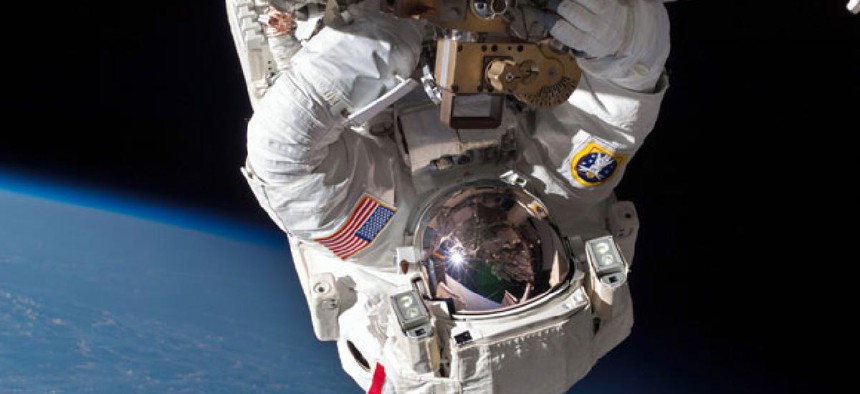The Future of the Spacesuit

Astronaut Chris Cassidy and Tom Marshburn, not pictured, perform a space walk to inspect and replace a pump controller box on the International Space Station on May 11, 2013. NASA/AP
It involves gyroscopes and better jetpacks.
NASA's first spacewalk, during the Gemini IV mission of 1965, came uncomfortably close to losing an astronaut. Ed White, stepping out into the abyss, found himself overcome with the joy that is sometimes referred to, fittingly, as "space euphoria." Floating in space was "the most natural feeling," he enthused to James McDivitt, the mission commander who was orchestrating White's walk from inside the Gemini capsule. White felt "just like a million dollars," he continued. "I've ... it's just tremendous."
White may have relished that first step into space a little too much, though. After 20 minutes of out-of-this-world bliss, Mission Control told its giddy star-sailor that it was time for him to return to his ship. And White ... refused. "Aw, Cape," he said, "let me just [take] a few pictures." After several minutes of back-and-forth -- Cape insisting, White resisting ("you almost could not drag me in," he admitted) -- Ed White finally, reluctantly, and belatedly began his return to the space capsule that was his only ticket back to Earth. It was, the astronaut would sigh, "the saddest moment of my life."
The scariest moment of Ed White's life, however, likely came within the next half hour. Because it ended up taking him 25 minutes to get back into the Gemini capsule. The craft's hatch experienced mechanical problems that made the door difficult to open and latch. And White's bulky spacesuit, all the while, was quickly losing its ability to protect its frail occupant from the surrounding void. The astronaut was using up his oxygen, rapidly. And here was the catch: if White should run out of air -- or, for that matter, if he should lose consciousness for any other reason while out in space -- McDivitt was under orders to cut him loose "rather than risk his own life trying to wrestle White back." Ed White's dreamy sojourn could have become, with a mission-saving snip of a tether, a nightmare.
We've come a long way since then. Spacewalks are now, of course, a regular occurrence. We've developed spacesuits that don't require their wearers to sacrifice themselves to the abyss should something go wrong during an EVA. Today's suits, unlike White's, are equipped with jetpacks that arm their wearers with thrusting power -- just enough to get them back to their ship or station should their tether become ... untethered. It's been a long time, thankfully, since an umbilical cord was an astronaut's only connection back to Mother Earth.
And yet spacesuits -- intricate spaceships made for a party of one -- are, like everything else NASA does, a work in progress. They are, despite the advances we've made in their design, notoriously unwieldy. They are rigid. They are bulky. They are heavy -- 310 pounds, not including their occupant, when in gravity. And they are, with their internal insulation and their external packs and their gloves that are more like mittens, really, really hard to maneuver. The suits are certainly effective at their primary jobs: keeping astronauts alive in space's void. They're much less effective, however, at letting astronauts act as explorers and wanderers and scientists and athletes. They're much less effective at letting astronauts be, you know, astronauts. NASA sums it up nicely: "These suits are officially known as EMUs -- extravehicular mobility units -- but they allow only limited mobility."





